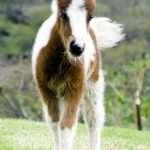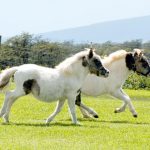The History of Miniature Horses
 The result of nearly 400 years of selective breeding, today’s Miniature Horse is refined and well-proportioned. Miniature horses were initially bred from many different pony breeds for the purpose of developing a very small sized horse. In the 17th century they were bred as pets for Europe’s Hapsburg nobility. However, not all miniatures were bred to become pets. Throughout the 19th century, they were used as work horses in the coal mines of England and Northern Europe until the 1950’s. For those who have yet to see an American Miniature Horse or have made the discovery and want to know more, an exciting new world awaits!
The result of nearly 400 years of selective breeding, today’s Miniature Horse is refined and well-proportioned. Miniature horses were initially bred from many different pony breeds for the purpose of developing a very small sized horse. In the 17th century they were bred as pets for Europe’s Hapsburg nobility. However, not all miniatures were bred to become pets. Throughout the 19th century, they were used as work horses in the coal mines of England and Northern Europe until the 1950’s. For those who have yet to see an American Miniature Horse or have made the discovery and want to know more, an exciting new world awaits!
One can’t help but smile when introduced to the American Miniature Horse. Youth, adults, special needs and older individuals enjoy this amazing and unique breed in many ways: as investments, show partners, or companions. Children who may be afraid of the standard-size horse often jump at the chance to embrace a Miniature Horse or foal. And the foals are especially lovable at 16 to 21 inches in height at birth! Adults, too, are reaping the rewards of Miniature Horse ownership. Transcending generations, it is not uncommon to see entire families from grandparent to grandchild working together to care for or work with their horses. Miniature Horse ownership encourages a wonderful learning experience and sense of accomplishment.
 Special needs individuals find the Miniature Horse an excellent substitute for the full-sized horse. Miniature Horses have long been used in therapeutic settings with positive results. Older individuals, no longer as mobile and preferring not to manage a standard-size horse are discovering the benefits of the Miniature Horse whether in competition, recreation or as an investment.
Special needs individuals find the Miniature Horse an excellent substitute for the full-sized horse. Miniature Horses have long been used in therapeutic settings with positive results. Older individuals, no longer as mobile and preferring not to manage a standard-size horse are discovering the benefits of the Miniature Horse whether in competition, recreation or as an investment.
The versatile American Miniature Horse makes an ideal show partner with talents ranging from halter and jumping to driving and obstacle. The opportunities are endless. AMHA & AMHR offer several divisions of competition including youth, amateur, special needs, and open. In the AMHA & AMHR show ring, individuals learn competitiveness and sportsmanship. The thrill and satisfaction from winning that first blue ribbon make effort worthwhile; and, while winning is exciting, striving for a personal best is often the greatest satisfaction.
 Guiding a young child in the proper care of the American Miniature Horse encourages discipline, responsibility and respect. Working with a Miniature Horse builds confidence and self-esteem – important qualities that carry over into adult life. Maintaining a Miniature Horse costs about one-tenth that of maintaining a large horse. The feeding program is basically the same but clean-up detail is much, much smaller. Care and maintenance for these petite equines can be performed safely by persons of any age, including children.
Guiding a young child in the proper care of the American Miniature Horse encourages discipline, responsibility and respect. Working with a Miniature Horse builds confidence and self-esteem – important qualities that carry over into adult life. Maintaining a Miniature Horse costs about one-tenth that of maintaining a large horse. The feeding program is basically the same but clean-up detail is much, much smaller. Care and maintenance for these petite equines can be performed safely by persons of any age, including children.
The above information was obtained from the website: The Miniature Horse.com.
GLOSSARY
American Miniature Horse: A horse measuring 34 inches or less at the withers that meets all requirements for registration with the American Miniature Horse Association (AMHA).
Blemish: Injury or imperfection that does not affect the horse’s service ability.
Bred: Mated.
Breeder: The owner or lessee of the dam at the time of service.
Broodmare: A mare that has been mated and is used to produce foals.
Certificate of Registration: Issued by the American Miniature Horse Association, it is the legal title certifying a horse has met all requirements for registration with AMHA. The Certificate lists pedigree of the horse, its registration number, the signature of the AMHA Registrar, the Association’s seal, the color of the horse, a written description of all markings, a photograph of the horse, the breeder and all ownership information.
Colt: A male horse, four-years-old or younger.
Conformation: The physical structure of the horse.
Cryptorchid: An ungelded male horse of any age that has one or more undescended testes.
Dam: A horse’s female parent.
Farrier: A blacksmith or horseshoer.
Filly: A female horse, four-years-old or younger.
Foal: A young horse of any sex in its first year of life. When used as a verb (to foal), it means to give birth.
Gait: Movements of the horse at various speeds. The gaits of the horse are the walk, trot, canter, and gallop.
Gelding: A castrated male horse.
Get: A stallion’s offspring.
In foal: Describes a pregnant mare.
Mare: A female horse.
Markings: Identifiable features on a horse such as stars, blazes, and white areas on the legs. Markings should be described by size, shape, and location on the body.
Open: A mare that is not in foal.
Pedigree: A record tracking a horse’s ancestry.
Produce: A mare’s offspring.
Sire: A horse’s male parent.
Sound: Normal and healthy: free from injury or flaw.
Stallion: An uncastrated male horse.
Tack: Equipment such as halters, harness, etc.
Weanling: A foal of any sex in its first calendar year of life, once he or she has been weaned from the dam.
Yearling: A horse of any sex in its second calendar year of life, beginning January 1 of the year following its birth.
